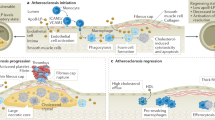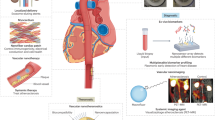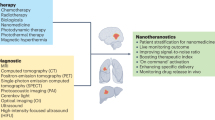Abstract
Targeted imaging and therapeutics is becoming a field of prime importance in the study and treatment of cardiovascular disease; it promises to enable early diagnosis, promote improved understanding of pathology, and offer a way to improve therapeutic efficacy. Agents, particularly for cardiovascular disease, have been reported to permit the in vivo imaging, by multiple modalities, of macrophages, vascular targets such as vascular cell adhesion molecule 1, and markers for angiogenesis such as αvβ3 integrin. In this Article, we first discuss the general concept of multimodality nanoparticles and then focus in greater depth on their clinical application for molecular imaging and therapy. Lastly, several examples of cardiovascular applications are discussed, including combined imaging and therapy approaches.
Key Points
-
The field of targeted imaging and therapeutics by the use of nanoparticles is rapidly expanding and becoming of prime importance in the study and treatment of cardiovascular disease
-
The use of nanoparticles promises to facilitate early diagnosis and improve the understanding of the pathology of cardiovascular disease, and offers ways to increase therapeutic efficacy of treatments for cardiovascular conditions
-
Agents have been reported that enable the in vivo imaging of macrophages, vascular targets such as cell adhesion molecules, and markers for angiogenesis, by a variety of imaging modalities
-
Targeted nanotherapeutics is considered to be one of the most promising new methods of therapeutic intervention for cardiovascular disease
This is a preview of subscription content, access via your institution
Access options
Subscribe to this journal
Receive 12 print issues and online access
$209.00 per year
only $17.42 per issue
Buy this article
- Purchase on Springer Link
- Instant access to full article PDF
Prices may be subject to local taxes which are calculated during checkout




Similar content being viewed by others
References
Choudhury RP et al. (2004) Molecular, cellular and functional imaging of atherothrombosis. Nat Rev Drug Discov 3: 913–925
Jaffer FA et al. (2006) Molecular and cellular imaging of atherosclerosis: emerging applications. J Am Coll Cardiol 47: 1328–1338
Weissleder R and Mahmood U (2001) Molecular imaging. Radiology 219: 316–333
Mulder WJ et al. (2006) Lipid-based nanoparticles for contrast-enhanced MRI and molecular imaging. NMR Biomed 19: 142–164
Mulder WJ et al. (2007) Magnetic and fluorescent nanoparticles for multimodality imaging. Nanomedicine 2: 307–324
Frullano L and Meade TJ (2007) Multimodal MRI contrast agents. J Biol Inorg Chem 12: 939–949
Mulder WJ et al. (2005) MR molecular imaging and fluorescence microscopy for identification of activated tumor endothelium using a bimodal lipidic nanoparticle. FASEB J 19: 2008–2010
Josephson L et al. (2002) Near-infrared fluorescent nanoparticles as combined MR/optical imaging probes. Bioconjug Chem 13: 554–560
Moghimi SM et al. (2005) Nanomedicine: current status and future prospects. FASEB J 19: 311–330
Midgley PA et al. (2007) Nanotomography in the chemical, biological and materials sciences. Chem Soc Rev 36: 1477–1494
Wickline SA et al. (2006) Applications of nanotechnology to atherosclerosis, thrombosis, and vascular biology. Arterioscler Thromb Vasc Biol 26: 435–441
Bangham AD et al. (1965) Diffusion of univalent ions across the lamellae of swollen phospholipids. J Mol Biol 13: 238–252
Torchilin VP (2005) Recent advances with liposomes as pharmaceutical carriers. Nat Rev Drug Discov 4: 145–160
Aragnol D and Leserman LD (1986) Immune clearance of liposomes inhibited by an anti-Fc receptor antibody in vivo. Proc Natl Acad Sci USA 86: 2699–2703
Allen TM and Hansen C (1991) Pharmacokinetics of stealth versus conventional liposomes: effect of dose. Biochim Biophys Acta 1068: 133–141
Allen TM et al. (1991) Liposomes containing synthetic lipid derivatives of poly(ethylene glycol) show prolonged circulation half-lives in vivo. Biochim Biophys Acta 1066: 29–36
Soo Choi H et al. (2007) Renal clearance of quantum dots. Nat Biotechnol 25: 1165–1170
Liu Y et al. (2007) Nanomedicine for drug delivery and imaging: a promising avenue for cancer therapy and diagnosis using targeted functional nanoparticles. Int J Cancer 120: 2527–2537
Yih TC and Wei C (2005) Nanomedicine in cancer treatment. Nanomedicine 1: 191–192
Sofou S (2007) Surface-active liposomes for targeted cancer therapy. Nanomedicine 2: 711–724
Allen TM (2002) Ligand-targeted therapeutics in anticancer therapy. Nat Rev Cancer 2: 750–763
Bulte JW and Kraitchman DL (2004) Iron oxide MR contrast agents for molecular and cellular imaging. NMR Biomed 17: 484–499
Michalet X et al. (2005) Quantum dots for live cells, in vivo imaging, and diagnostics. Science 307: 538–544
Lanza GM et al. (2006) Nanomedicine opportunities for cardiovascular disease with perfluorocarbon nanoparticles. Nanomedicine 1: 321–329
Romberg B et al. (2008) Sheddable coatings for long-circulating nanoparticles. Pharm Res 25: 55–71
Rutten A and Prokop M (2007) Contrast agents in X-ray computed tomography and its applications in oncology. Anticancer Agents Med Chem 7: 307–316
Kim D et al. (2007) Antibiofouling polymer-coated gold nanoparticles as a contrast agent for in vivo X-ray computed tomography imaging. J Am Chem Soc 129: 7661–7665
Rabin O et al. (2006) An X-ray computed tomography imaging agent based on long-circulating bismuth sulphide nanoparticles. Nat Mater 5: 118–122
Strijkers GJ et al. (2007) MRI contrast agents: current status and future perspectives. Anticancer Agents Med Chem 7: 291–305
Morawski AM et al. (2005) Targeted contrast agents for magnetic resonance imaging and ultrasound. Curr Opin Biotechnol 16: 89–92
Roby A et al. (2007) Enhanced in vivo antitumor efficacy of poorly soluble PDT agent, meso-tetraphenylporphine, in PEG-PE-based tumor-targeted immunomicelles. Cancer Biol Ther 6: 1136–1142
Gulati M et al. (1998) Lipophilic drug derivatives in liposomes. Int J Pharm 165: 129–168
Lanza GM et al. (2002) Targeted antiproliferative drug delivery to vascular smooth muscle cells with a magnetic resonance imaging nanoparticle contrast agent: implications for rational therapy of restenosis. Circulation 106: 2842–2847
Liu Y et al. (2007) Nanomedicine for drug delivery and imaging: a promising avenue for cancer therapy and diagnosis using targeted functional nanoparticles. Int J Cancer 120: 2527–2537
O'Neal DP et al. (2004) Photo-thermal tumor ablation in mice using near infrared-absorbing nanoparticles. Cancer Lett 209: 171–176
Hood JD et al. (2002) Tumor regression by targeted gene delivery to the neovasculature. Science 296: 2404–2407
Mastrobattista E et al. (2002) Targeted liposomes for delivery of protein-based drugs into the cytoplasm of tumor cells. J Liposome Res 12: 57–65
Mulder WJ et al. (2004) A liposomal system for contrast-enhanced magnetic resonance imaging of molecular targets. Bioconjug Chem 15: 799–806
Kao CY et al. (2003) Long-residence-time nano-scale liposomal iohexol for X-ray-based blood pool imaging. Acad Radiol 10: 475–483
Hamilton A et al. (2002) Left ventricular thrombus enhancement after intravenous injection of echogenic immunoliposomes: studies in a new experimental model. Circulation 105: 2772–2778
Marik J et al. (2007) Long-circulating liposomes radiolabeled with [18F]fluorodipalmitin ([18F]FDP). Nucl Med Biol 34: 165–171
Harrington KJ et al. (2001) Effective targeting of solid tumors in patients with locally advanced cancers by radiolabeled pegylated liposomes. Clin Cancer Res 7: 243–254
Torchilin VP (2007) Micellar nanocarriers: pharmaceutical perspectives. Pharm Res 24: 1–16
Torchilin VP (2004) Targeted polymeric micelles for delivery of poorly soluble drugs. Cell Mol Life Sci 61: 2549–2559
Fortina P et al. (2007) Applications of nanoparticles to diagnostics and therapeutics in colorectal cancer. Trends Biotechnol 25:145–152
Vogl TJ et al. (1996) Magnetic resonance imaging of focal liver lesions: comparison of the superparamagnetic iron oxide resovist versus gadolinium-DTPA in the same patient. Invest Radiol 31: 696–708
Mack MG et al. (2002) Superparamagnetic iron oxide-enhanced MR imaging of head and neck lymph nodes. Radiology 222: 239–244
Tang T et al. (2006) Assessment of inflammatory burden contralateral to the symptomatic carotid stenosis using high-resolution ultrasmall, superparamagnetic iron oxide-enhanced MRI. Stroke 37: 2266–2270
de Vries IJ et al. (2005) Magnetic resonance tracking of dendritic cells in melanoma patients for monitoring of cellular therapy. Nat Biotechnol 23: 1407–1413
McCarthy JR et al. (2007) Targeted delivery of multifunctional magnetic nanoparticles. Nanomedicine 2: 153–167
Kircher MF et al. (2003) A multimodal nanoparticle for preoperative magnetic resonance imaging and intraoperative optical brain tumor delineation. Cancer Res 63: 8122–8125
Jaffer FA et al. (2006) Cellular imaging of inflammation in atherosclerosis using magnetofluorescent nanomaterials. Mol Imaging 5: 85–92
Nahrendorf M et al. (2006) Noninvasive vascular cell adhesion molecule-1 imaging identifies inflammatory activation of cells in atherosclerosis. Circulation 114: 1504–1511
Mulder WJ et al. (2006) Quantum dots with a paramagnetic coating as a bimodal molecular imaging probe. Nano Lett 6: 1–6
Frias JC et al. (2004) Recombinant HDL-like nanoparticles: a specific contrast agent for MRI of atherosclerotic plaques. J Am Chem Soc 126: 16316–16317
Zheng G et al. (2005) Rerouting lipoprotein nanoparticles to selected alternate receptors for the targeted delivery of cancer diagnostic and therapeutic agents. Proc Natl Acad Sci USA 102: 17757–17762
Frias JC et al. (2006) Properties of a versatile nanoparticle platform contrast agent to image and characterize atherosclerotic plaques by magnetic resonance imaging. Nano Lett 6: 2220–2224
Svenson S and Tomalia DA (2005) Dendrimers in biomedical applications—reflections on the field. Adv Drug Deliv Rev 57: 2106–2129
Anderson EA et al. (2006) Viral nanoparticles donning a paramagnetic coat: conjugation of MRI contrast agents to the MS2 capsid. Nano Lett 6: 1160–1164
Bridot JL et al. (2007) Hybrid gadolinium oxide nanoparticles: multimodal contrast agents for in vivo imaging. J Am Chem Soc 129: 5076–5084
Rieter WJ et al. (2007) Hybrid silica nanoparticles for multimodal imaging. Angew Chem Int Ed Engl 46: 3680–3682
Sitharaman B et al. (2005) Superparamagnetic gadonanotubes are high-performance MRI contrast agents. Chem Commun (Camb) 3915–3917
Ruehm SG et al. (2001) Magnetic resonance imaging of atherosclerotic plaque with ultrasmall superparamagnetic particles of iron oxide in hyperlipidemic rabbits. Circulation 103: 415–422
Kooi ME et al. (2003) Accumulation of ultrasmall superparamagnetic particles of iron oxide in human atherosclerotic plaques can be detected by in vivo magnetic resonance imaging. Circulation 107: 2453–2458
Amirbekian V et al. (2007) Detecting and assessing macrophages in vivo to evaluate atherosclerosis noninvasively using molecular MRI. Proc Natl Acad Sci USA 104: 961–966
Hyafil F et al. (2007) Noninvasive detection of macrophages using a nanoparticulate contrast agent for computed tomography. Nat Med 13: 636–641
Winter PM et al. (2006) Endothelial alpha(v)beta3 integrin-targeted fumagillin nanoparticles inhibit angiogenesis in atherosclerosis. Arterioscler Thromb Vasc Biol 26: 2103–2109
Medarova Z et al. (2007) In vivo imaging of siRNA delivery and silencing in tumors. Nat Med 13: 372–377
Pissuwan D et al. (2006) Therapeutic possibilities of plasmonically heated gold nanoparticles. Trends Biotechnol 24: 62–67
Samia AC et al. (2003) Semiconductor quantum dots for photodynamic therapy. J Am Chem Soc 125: 15736–15737
Roy I et al. (2005) Optical tracking of organically modified silica nanoparticles as DNA carriers: a nonviral, nanomedicine approach for gene delivery. Proc Natl Acad Sci USA 102: 279–284
Ogawara K et al. (2006) Functional inhibition of NF-kappaB signal transduction in alphavbeta3 integrin expressing endothelial cells by using RGD-PEG-modified adenovirus with a mutant IkappaB gene. Arthritis Res Ther 8: R32
Author information
Authors and Affiliations
Corresponding author
Ethics declarations
Competing interests
The authors declare no competing financial interests.
Rights and permissions
About this article
Cite this article
Mulder, W., Cormode, D., Hak, S. et al. Multimodality nanotracers for cardiovascular applications. Nat Rev Cardiol 5 (Suppl 2), S103–S111 (2008). https://doi.org/10.1038/ncpcardio1242
Received:
Accepted:
Issue Date:
DOI: https://doi.org/10.1038/ncpcardio1242
This article is cited by
-
Polyethylene glycol-modified dendrimer-entrapped gold nanoparticles enhance CT imaging of blood pool in atherosclerotic mice
Nanoscale Research Letters (2014)
-
Nanomedical Theranostics in Cardiovascular Disease
Current Cardiovascular Imaging Reports (2012)
-
Diagnostic and therapeutic strategies for small abdominal aortic aneurysms
Nature Reviews Cardiology (2011)
-
Insights into Atherosclerosis Using Nanotechnology
Current Atherosclerosis Reports (2010)
-
Nanoparticles for concurrent multimodality imaging and therapy: The dawn of new theragnostic synergies
European Journal of Nuclear Medicine and Molecular Imaging (2009)



